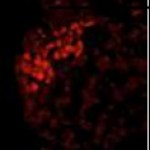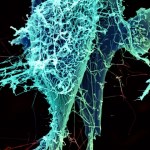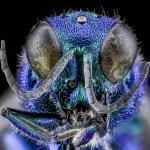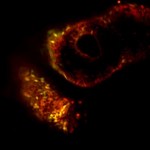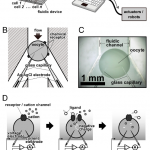genetic engineering
Getting cells to revert to a stem-like state – creating so-called induced pluripotent stem (iPS) cells – was a true revolution, but the technique invented in 2006 is only half the game. The first challenges include getting enough adult cells to undergo the “reprogramming” in culture to be of use and removing those traces of “priming” that distinguish them from true embryonic stem cells. The second is keeping them in the iPS state – that is, holding back their urge to differentiate – in lab conditions. And then there is the challenge of directing their differentiation in the way that you want…
New research from the Weizmann Institute of Science reveals that "cells in our brain form little hexagonal grids that keep us oriented, map-like, in our surroundings." Weizmann's resident blogger describes this finding as "a pyrotechnic flash of insight that changes how we understand the brain to work." Game developers delight; this discovery shows "that you can really apply mathematical models to understand how our mammalian brains get their bearings." It may also have immediate implications for understanding human brain disorders such as vertigo. Meanwhile, on ERV, Abbie Smith explores a…
As an unprecedented outbreak of Ebola crosses borders in West Africa, people are asking new questions about the virus and its potential to turn into a global pandemic (hint: it's not gonna happen). Greg Laden writes "The disease is too hot to not burn itself out, and it has no human reservoir. Ebola accidentally broke into the human population earlier this year or late last year." The current numbers from the WHO suggest 1800 confirmed and suspected cases of Ebola so far with a mortality rate edging down toward 55%.
Last week some in the U.S. objected to bringing two American patients…
Perovskite solar cells can not only emit light, they can also emit up to 70% of absorbed sunlight as lasers.
Critical signaling molecules can be used to convert stem cells to neural progenitor cells, increasing the yield of healthy motor neurons and decreasing the time required to grow them.
Mexican blind cavefish are so close to their sighted kin that they are considered the same species, but they use pressure waves (from opening and closing their mouths) to navigate in the dark.
Electrostatic assembly allows luminescent elements (like Europium) to be embedded in nanodiamonds; these glowing…
In the future, stem cells created from our own skin cells will be used to renew damaged organs or grow new ones. We know this promise has often been made before, but the latest research in the lab of Dr. Jacob (Yaqub) Hanna is producing some solid findings that may make you believe in the possibility.
Just a little over a month ago, we reported that Hanna and his group had discovered a “brake” that keeps our cells from easily reverting to an embryonic-stem-cell-like state (induced pluripotent stem cells, or iPS cells). Removing that brake enabled them to ramp up the conversion process – in…
Can you be skeptical about GM but believe in climate change? So asks Alice Bell in The Guardian. The answer is of course, "Yes," but you can also be a fundamentalist Christian while believing in evolution and being a great scientist, so being able to hold two things in your brain at the same time is not a useful measure of logical incompatibility. One can be right about one thing and wrong about the other.
But let's get to the real issue raised in Bell's piece, the use of the term "anti-science" to describe opponents of genetically modified organisms (GMOs):
When people use the…
On Thursday, I had a post published on Scientific American's guest Blog about claims that genetically modified food crops could contain allergens. In it, I am critical of the Union of Concerned Scientists (a science advocacy and policy organization), for what I read as misplaced opposition to genetic engineering:
The UCS’s concern about the dire state of our food system is well-founded, and I applaud their efforts to get out in front of the policy debate. There’s just one problem: they oppose using all of our technology to help combat this problem. Specifically, I’m talking about…
Last month, Penn Medicine put out a press release heralding a "cancer treatment breakthrough 20 years in the making." In a small clinical trial, three patients with advanced chronic lymphocytic leukemia (CLL) were treated with genetically engineered versions of their own T cells. Just a few weeks after treatment the tumors had disappeared, and the patients remained in remission for a year before the study was published.
The release didn't, however, explain those "20 years in the making." In 1989, Prof. Zelig Eshhar of the Weizmann Institute's Immunology Department first published a paper…
This week, two press releases from the Institute:
The first was on the sequencing of the woodland strawberry genome (unfortunately, in the same week the cacao genome was sequenced). The Institute scientists who participated in the project contributed in the computational analysis of genes encoding flavor- and aroma-related proteins.
This wild cousin of the cultivated strawberry is a member of the rose family, along with fruit trees including apples, peaches, cherries and almonds. In other words, this small annual plant is sure to become a useful experimental model for plant and agricultural…
The Economist is running an online debate and we need your vote.
Vote here.
My opening statement:
The number of people on Earth is expected to increase from the current 6.7 billion to 9 billion by 2050 with food demands expected to rise by 70%. How will we feed them? If we continue with current farming practices, vast amounts of wilderness will be lost, millions of birds and billions of insects will die, scarce water will be wasted, greenhouse gas emissions will increase and farm workers will be exposed to harmful chemicals. Clearly, the future of our planet requires that we improve the…
A lot of synthetic biology is about getting biology to be more like electrical engineering, designing genetic "logic gates" to create a living circuit board. Beyond analogies, however, cells have many fascinating electrical properties--proteins that transfer electrons like wires, membranes that separate ions and create an electrical charge that drives the metabolism of the cell, channels through these membranes that open and close to activate an electro-biological response. Electrons are electrons whether they are in proteins or copper wires, and many scientists have designed ways to connect…
Sometimes among all of the tedious protocols and mundane inconclusive data, I forget that I'm doing something amazing and incredibly powerful. Almost all my experiments require altering a living organism to do my bidding--to hold onto and replicate a piece of DNA that I'm interested in or to produce an enzyme that I want a lot of. Thanks to iGEM this summer I've gotten to learn some new soon-to-be-tedious protocols that seem absolutely thrilling now, and the experience is reminding me of how awesome (in the real sense of the word) genetic engineering is.
The team is working with the model…
In a recent conversation about the safety and ethics of synthetic biology in the wake of the announcement of the synthetic genome, many of the professors I was chatting with commented on how they hoped new synthetic biology technology would lead to bacteria that could eat the oil spilling into the gulf of mexico even as I type this right now. Of course, the "technology" for oil eating bacteria already exists and have already been used for clean up in previous oil spills--many naturally occurring species of bacteria can already break down the hydrocarbons in crude oil. The natural oil eaters…
Silk is an amazing biomaterial, cultivated and prized for more than 5,000 years. The silk threads that we weave into our shiny fabrics are actually enormous protein crystals produced by insects. This industrial silk that you can buy at the mall is made by silkworms, which use the silk to form the cocoon that protects them as they transform into moths. Many other species of insect also produce silk proteins to protect themselves or their eggs, get around, or catch their prey, but none in such enormous quantity in such easy to harvest packages as the silkworm. Silks from different species are…
The number of people on Earth is expected to shoot up from the current 6.7 billion to 9.2 billion by 2050. How will we feed them? If we continue with current farming practices, vast amounts of wilderness will be lost, millions of birds and billions of insects will die, and farm workers will be exposed to more and more chemicals. And still, we will not have enough food. Clearly, there must be a better way.
Some scientists and policymakers suggest that genetic engineering, a modern form of crop modification, will dramatically reduce our dependence on pesticides, enhance the health of our…
That's how new life forms are created every day in the wild, folks. Human researchers of course have added a few twists on the theme. If we can't induce bacteria or animal cells to collect new bits of DNA on their own, we turn to electroshock therapy. With plants.... aw heck, we just shoot them.
And where did this crazy rant come from you ask? Last Saturday morning, at the crack of 9 am I got to be interviewed on a radio program with two of the main spokespeople from the DIY bio movement, Mackenzie Cowell and Meredith Patterson.
The program was "The Food Chain" (you can listen to it…
A large study weighs up the existing evidence on the impact of GM crops on local insect life, providing some much-needed scientific rigour to the GM debate.
In Europe, the 'GM debate' about the merits and dangers of genetically-modified (GM) crops is a particularly heated one. There is a sense of unease about the power of modern genetic technology, and a gut feeling that scientists are 'playing God'. These discontents are stoked by the anti-GM camp, who describe GM crops with laden and fear-mongering bits of unspeak like 'Frankenstein foods' and 'unnatural'.
In a debate so fuelled by…
As the field of genetics sheds its sci-fi image and gains approval in the public eye, the possibilities unravel for mainstream commercial use. But some worry that if couples can use In-Vitro Fertilization to screen for disease during pre-implantation procedures, they could use it to select desired physical characteristics like eye color and gender as well, as dozens of couples from Australia have been traveling to the U.S. to do. But ScienceBlogger Daniel MacArthur from Genetic Future doesn't anticipate that this recent trend will catch on, and discusses why he thinks there won't be a large…
